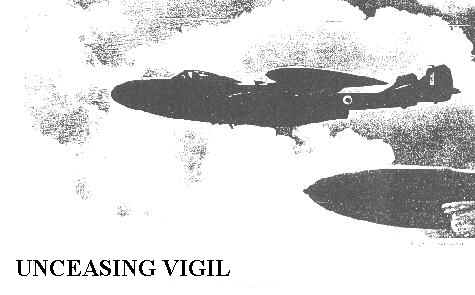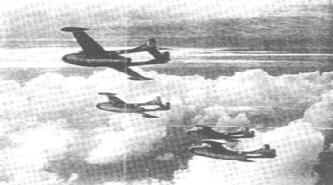 |
As darkness falls a 23 Squadron aircraft heads out over the North Sea on a practice interception. |
from FLIGHT INTERNATIONAL, 23 December 1955
 |
As darkness falls a 23 Squadron aircraft heads out over the North Sea on a practice interception. |
NIGHT'S BLACK AGENTS
The Work of the Venom NF-3's of 23 and 141 Squadrons at Coltishall
By night or day, in fair weather or foul, D.H. Venom NF3's provide home-based night fighter squadrons of the RAF with a defensive weapon of formidable capability.
"Only birds and fools fly," goes the saying, "and birds don't fly at night." Epigrammatic, but innacurate, since many obirds of prey are specially equipped to kill in the dark, which they do with uncanny efficiency and in any kind of weather. Rising as the sun goes down they may be heard about their predatory business at any hour of the night; and at this time of the year, when darkness falls early and the night is long, their activity is at its highest.
But with the dawn they are grounded and helpless, and then no further analogy may be drawn between them and their man-made counterparts, the all-weather fighters, which are as competent in daylight as they are in darkness. Such aircraft as the de Havilland Venom NF-3 which now requip all-weather squadrons of the Royal Air Force, make sense of the oft-heard phrase '24-hour preparedness'; and, backed by a ground radar system which is probably the most effective in the world, they carry full responsibility for seeking, intercepting and destroying an enemy in the thickest weather and on the blackest of nights.
| Twilight formation by 23 Squadron with cumulus threatening dirty weather for the coming night. |  |
The Venom NF3 was issued to the RAF in the summer, and was first exercised in 'Beware' (reported in Flight for September 30th and October 7th). It superseded the Venom 2 being a considerably more effective development of that formidable fighter, particularly as to its advanced type of interception radar. Performance is secret, but it may be said that in one respect at least - the ability to climb very quickly to a great height - it probably outstrips any all-weather fighter in service. And its agility and speed at altitude are factors to be reckoned with, as many 'hostile' Canberra crew have discovered.
The first RAF squadron to be re-equipped with Venom 3s was No 141 (Wing Commander C.P. Chilton DSO DFC) which shared with another illustrious night-fighter squadron, No 23 (Wing Commander A.N. Davies, DSO DFC) the East Coast station at Coltishall, Norfolk, now commanded by Group Captain J.C. Sisson CBE DFC. A fortnight ago Flight was privileged to visit the station to see both squadrons at work. Our host was the wing commander flying, Wing Commander M.H. Constable Maxwell DSO DFC under whom the two squadrons operate in close and keenly competitive partnership. The senior technical and administrative officers at the station are respectively Wing Commander G.V. Meredith MBE and Wing Commander R.G. Prior DFC.
Before describing, within the bounds of very rigid security, the activities of the two squadrons, it is appropriate to consider night and all-weather flying in its broader aspects, as an art, a science and challenge.
Night flying, which includes by implication all-weather flying, has always been one of those jobs that most fighter pilots prefer to leave to the other man. The reasons are not hard to seek. Pilots of a day fighter squadron feel that they are experiencing flying at its best: they like the comradeship of hunting as a team, the fun of formation flying and aerobatics, the excitement of low-flying (in approved areas) and ground attack. The thought of operating in darkness as a regular job, of exchanging art for electronics, does not appeal very much; and pilots, who are no less diurnal by habit than other human beings, have an instinctive respect for 'unnatural night.' Not for them, the day fighter pilots say, a flying job which, because they have not experienced it, they imagine as dull and shackled to science - in short, to use the jargon of the day, deadbeat.
It is no national secret that the country's night fighter force, having during the war reached the highest summit of efficiency, subsequently declined. It is only in the last few years that it has been built up to the potent state in which we see it today, and it is still expanding, as anyone who has seen the Javelin production lines might deduce. The demand for crews is insatiable, and pilots are drawn not only from the flying training schools (Provost and Vampire T 11) via the operational conversion units (Meteor NF 14) but, after a spell at an OCU from the day fighter squadrons as well. One can thus imagine the feelings of many day pilots when they learn that they are to be posted to a night fighter squadron after a tour back at Training Command. One fact, they affect, surpassed only by the other!
But those who have tasted life with an all-weather squadron discover that it offers a satisfaction found perhaps in no other form of flying. Night operations comprise only a half of a round-the-clock programme that combines the fun and the art of day flying with the science and the challenge of night and all-weather work. One gets, as it were, the bun and the halfpenny as well - all the pleasures of day flying, plus a lot more. Science is enlisted to secure complete independence of weather and to seek out the quarry, but always there is a mind-over-matter exhilaration in - for example - the sudden sighting and killing of an enemy high up in the abyss of the night, only a few minutes after scrambling from the crew-room for a take-off in foul weather and a climb through perhaps 30,000ft of cloud.
The magic of moonlight on the cloud-tops, expecially when seen from extreme height, is a source of unfailing delight, and on clear nights the view is astonishing. It is quite easy to see the lights of London from 40,000 feet over the Zuider Zee and to pick out the myriad of tiny lights of shipping in the English Channel. And, on bad nights, landing after a ground-controlled approach - a long, low, bumpy penetration through cloud with nothing to see except the rain-streaking on the windscreen until the lights of the runway threshold suddenly appear - gives a feeling of satisfaction to even the most veteran pilots.
Before we turn from a general commentary on night flying to a detailed account of aircraft and crews at work, one particular point is worth recording. It is that, as a general rule, the best night fighter pilots are those with day fighter experience. To have mastered gunnery and instrument flying is an invaluable background to night fighting, in which the perfection of interception and combat techniques is one of the prime preoccupations. As one experienced pilot put it: 'Anyone can fly gently around at night doing nice precision turns, but to be an effective night-fighter he's got to be confident enough of his instrument flying to be able to throw the aeroplane around."
The two squadrons at Coltishall devote alternate weeks to day and night flying and in this way the full round-the-clock practice is maintained without undue strain being put upon aircrews and ground crews. The week before last, for instance, 23 Squadron worked the day shift, beginning flying at about 0900 hr and continuing until dusk. A typical day's work might include half-a-dozen sorties on one or more of a variety of missions: cross-countries, air-to-air gunnery with the station's Meteor 8 target tug, formation flying, instrument flying, GCA let-downs, and, of course, ground-vectored interceptions, usually of one Venom on another. In the afternoon, early or late depending upon the time of year, the duty night squadron - on the occasion of our visit, No 141 - flight-tests its Venoms in preparation for the night's work, in accordance with customary night-fighting practice. The night is spent mainly in performing ground-vectored interceptions, with Venoms working as pairs. 'Bomex' exercises, in which Canberras usually comprise the attacking force, are frequent. In the night of Thursday, December 8th, for example, a hostile force of more than 70 Canberras, on their way to bomb Weymouth, was intercepted by East Coast night fighter squadrons including No 141.
Perhaps the most entertaining vantage points for observing such an exercise is the squadron crew-room. Undoubtedly the best picture of the battle as a whole is obtained at Sector HQ, where every component of the defence machine, from the coastal radar stations to the aircraft at readniness at each of a number of night-fighter airfields, is co-ordinated. But in the crew-room one is closer to the heat of the fray; pilots and navigators hastily abandon a game of clag (more suitable than bridge, because of its shorter rubbers) to scramble, either straight from the apron to take-off, or to the operational-readiness platform at the end of the runway. From here Sector HQ can get an aircraft into the air at a moment's notice by means of the 'telescramble', even though the engine may have been switched off. A cartridge start, full power without a warm-up, and straight off on a GCI (ground controlled interception).
The wartime system of interceptions is in its essentials retained, but with certain significant differences that for security reasons cannot be described in detail. The whole machine has, in effect, been area-ruled in conformity with the contemporary tempo; an example is the 'recovery' procedure, by which any number of returning fighters, their gallons going fast, can be sorted out by the airfield control and brought straight onto the glide path at very short intervals, without overloading the GCA. Perfection of this procedure has been one of the most noteworthy successes of the RAF's all-weather operations. In place of the old QGH technique is a slick system in which fighters are brought in from all points of the compass, with allowance automatically made for the prevailing wind.
To return to the crew-room. Here one can listen in to the conversations of returning pilots and navigators, who only a few minutes before, it seemed, had left their card-games. Since then they have perhaps made several interceptions eight miles up over the Continent. Experiences are exchanged over the Esquire-decorated counter of the coffee-bar. The duty operations officer is heard to announce that both wing commanders have got three, which solicits the inevitable enquiry: 'Stripes or Canberras?' and others less respectful. One of the wing commanders returns, confirms that he got two Canberras and an odd B-45 ('that'll teach the USAF to tell people when and where they're flying') and asks to see the flight sergeant in charge of the ground crew about a half-minute delay before take-off.
The battle continues, each man a vital component of a vast and intricate mechanism the simple object of which is the annihilation of an enemy who may approach Britain's shores, by day or by night, and in any weather.
J.M.R.
Credit: John Brady
Transcript: Dave Clarke